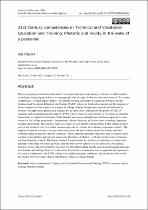| dc.contributor.author | Papier, Joy | |
| dc.date.accessioned | 2022-05-25T08:55:13Z | |
| dc.date.available | 2022-05-25T08:55:13Z | |
| dc.date.issued | 2021 | |
| dc.identifier.citation | Papier, J. (2021). 21st century competencies in technical and vocational education and training: Rhetoric and reality in the wake of a pandemic. Journal of Education (South Africa), (84), 67-84. doi:10.17159/2520-9868/I84A04 | en_US |
| dc.identifier.issn | 2520-9868 | |
| dc.identifier.uri | doi:10.17159/2520-9868/I84A04 | |
| dc.identifier.uri | http://hdl.handle.net/10566/7457 | |
| dc.description.abstract | There is general agreement about the need for vocational education and training to embrace so-called modern
technologies in gearing up to deliver to young people a broad range of what have become known as 21st century
competencies, of which digital literacy, self-directed learning, and adaptive learning are but three. Recent
Technical and Vocational Education and Training (TVET) policies in South Africa incorporate the language of
future competencies that ought to be acquired by college students through their curricula and delivered by
lecturers with appropriate professional training. But in April 2020, confronted by the global COVID-19
pandemic and an immediate hard lockdown, TVET colleges went into crisis mode to try to meet a government
demand that no student be left behind. While blended and remote methodologies had been employed to some
extent in a few college programmes, the pandemic suddenly launched all lecturers into technology dependent
teaching and learning. This article is based on a survey of conveniently selected public TVET college lecturers
early in the lockdown who were under enormous pressure to continue the academic programme remotely. The
snapshot I obtained was one of anxiety and consternation, but also of deep concern for students and their
wellbeing under inordinately difficult conditions. Their conflicting priorities while they tried to balance remote
teaching responsibilities and personal needs were illustrative of Maslow’s well-known theorisation of humans
and their hierarchy of needs. The limited research I conducted for this article was exploratory at a time in the
pandemic when there were more questions than answers in every sphere of social interaction. My findings,
therefore, do not seek to be definitive and there was full understanding that the education and training landscape
was dynamic and shifting. However, what can be shared here is a moment in time to appreciate the experiences
of a critical component of the TVET college sector under emergency conditions, and the distance they would
have had to traverse towards official exhortations to leave no student behind.
Keywords: | en_US |
| dc.language.iso | en | en_US |
| dc.publisher | University of KZN | en_US |
| dc.subject | Technical and Vocational Education and Training (TVET) | en_US |
| dc.subject | Future competencies | en_US |
| dc.subject | Curricula | en_US |
| dc.subject | Remote Learning | en_US |
| dc.title | 21st Century competencies in technical and vocational education and training: rhetoric and reality in the wake of a pandemic | en_US |
| dc.type | Article | en_US |

